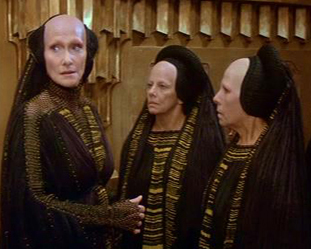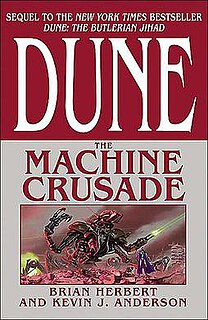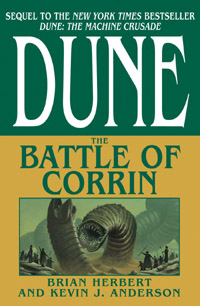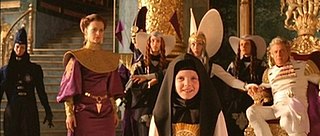
The Baron Vladimir Harkonnen is a fictional character from the Dune franchise created by Frank Herbert. He is primarily featured in the 1965 novel Dune and is also a prominent character in the Prelude to Dune prequel trilogy (1999–2001) by Brian Herbert and Kevin J. Anderson. The character is brought back as a ghola in the Herbert/Anderson sequels which conclude the original series, Hunters of Dune (2006) and Sandworms of Dune (2007).

The Bene Gesserit are a key social, religious, and political force in Frank Herbert's fictional Dune universe. The group is described as an exclusive sisterhood whose members train their bodies and minds through years of physical and mental conditioning to obtain superhuman powers and abilities that can seem magical to outsiders. Acolytes who have acquired the breadth of Bene Gesserit abilities are called Reverend Mothers within the organization's ranks.

A Guild Navigator is a fictional humanoid in the Dune universe created by Frank Herbert. In this series and its derivative works, starships called heighliners employ a scientific phenomenon known as the Holtzman effect to "fold space" and thereby travel great distances across the universe instantaneously. Humans mutated through the consumption of and exposure to massive amounts of the spice melange, Navigators are able to use a limited form of prescience to safely navigate interstellar space. Control of these Navigators gives the Spacing Guild its monopoly on interstellar travel and banking, making the organization a balance of power against the Padishah Emperor and the assembled noble Houses of the Landsraad.
Fire Emblem is a fantasy tactical role-playing game franchise developed by Intelligent Systems and published by Nintendo. First produced and published for the Family Computer in 1990, the series currently consists of sixteen core games and four spinoffs. Gameplay revolves around the tactical movement of characters across grid-based environments, while incorporating a story and characters similar to traditional role-playing video games.

Marth is a fictional character from the Fire Emblem series, developed by Intelligent Systems and owned by Nintendo. He is the protagonist and Lord class character in the first and the third games in the series, Fire Emblem: Shadow Dragon and the Blade of Light, and Fire Emblem: Mystery of the Emblem, as well as their two remakes, Fire Emblem: Shadow Dragon and Fire Emblem: New Mystery of the Emblem.

Brian Patrick Herbert is an American author who lives in Washington state. He is the elder son of science fiction author Frank Herbert.

Dune is a science fiction media franchise that originated with the 1965 novel Dune by Frank Herbert and has continued to add new publications. Dune is frequently cited as the best selling science fiction novel in history. It won the inaugural Nebula Award for Best Novel in 1965 and the 1966 Hugo Award, and was later adapted into a 1984 film and a 2000 television miniseries. Herbert wrote five sequels, and the first two were presented as a miniseries in 2003. The Dune universe has also inspired some traditional games and a series of video games. Since 2009, the names of planets from the Dune novels have been adopted for the real-world nomenclature of plains and other features on Saturn's moon Titan.

Dune: The Machine Crusade is a 2003 science fiction novel by Brian Herbert and Kevin J. Anderson, set in the fictional Dune universe created by Frank Herbert. It is the second book in the Legends of Dune prequel trilogy, which takes place over 10,000 years before the events of Frank Herbert's celebrated 1965 novel Dune. The series chronicles the fictional Butlerian Jihad, a crusade by the last free humans in the universe against the thinking machines, a violent and dominating force led by the sentient computer mind Omnius.

Dune: The Battle of Corrin is a 2004 science fiction novel by Brian Herbert and Kevin J. Anderson, set in the fictional Dune universe created by Frank Herbert. It is the third book in the Legends of Dune prequel trilogy, which takes place over 10,000 years before the events of Frank Herbert's celebrated 1965 novel Dune. The series chronicles the fictional Butlerian Jihad, a crusade by the last free humans in the universe against the thinking machines, a violent and dominating force led by the sentient computer Omnius.

A series of Duneshort stories have been written that relate to the Dune novels by Frank Herbert, Brian Herbert and Kevin J. Anderson. Some of these stories were originally available for download from the official Dune website, released in a promotional capacity in conjunction with the Brian Herbert/Kevin J. Anderson novels. "Dune: A Whisper of Caladan Seas", "Dune: Hunting Harkonnens", "Dune: Whipping Mek", and "Dune: The Faces of a Martyr" were later published as part of the collection The Road to Dune released in September 2005. "Dune: Sea Child" was published in Elemental, a 2006 benefit anthology for children who survived the 2004 Indian Ocean tsunami, and was later made available as part of the paperback edition of The Road to Dune. "Dune: Treasure in the Sand" was published online in 2006 at Jim Baen's Universe, and was later made available as part of the paperback edition of Hunters of Dune. "Dune: Wedding Silk" was released June 12, 2011 in the Dune e-book short story collection Tales of Dune, which also included previously published stories "Dune: Sea Child" and "Dune: Treasure in the Sand." "Dune: Red Plague" was released on November 1, 2016, followed by "Dune: The Waters of Kanly" in the short story collection Infinite Stars on October 17, 2017.

Sisterhood of Dune is a 2012 science fiction novel by Brian Herbert and Kevin J. Anderson, set in the Dune universe created by Frank Herbert. It is the first book in their Great Schools of Dune prequel trilogy, which itself is a sequel to their Legends of Dune trilogy. The book is set eighty years after the events of 2004's Dune: The Battle of Corrin, in which the human military finally defeat the thinking machine armies of Omnius. Now, the fledgling Bene Gesserit, Mentat and Suk Schools, as well as the Spacing Guild, are threatened by the independent anti-technology forces gaining power in the aftermath of the Butlerian Jihad. The Great Schools of Dune trilogy, first mentioned by Anderson in a 2010 blog post, will chronicle the early years of these organizations, which figure prominently in the original Dune novels.
Nobunaga Shimazaki is a Japanese voice actor affiliated with Aoni Production. He won the Best Rookie Actor Award at the 7th Seiyu Awards.

Multiple organizations of the Dune universe dominate the political, religious, and social arena of the fictional setting of Frank Herbert's Dune series of science fiction novels, and derivative works. Set tens of thousands of years in the future, the saga chronicles a civilization which has banned computers but has also developed advanced technology and mental and physical abilities through physical training, eugenics and the use of the drug melange. Specialized groups of individuals have aligned themselves in organizations focusing on specific abilities, technology and goals. Herbert's concepts of human evolution and technology have been analyzed and deconstructed in at least one book, The Science of Dune (2008). His originating 1965 novel Dune is popularly considered one of the greatest science fiction novels of all time, and is frequently cited as the best-selling science fiction novel in history. Dune and its five sequels by Herbert explore the complex and multilayered interactions of politics, religion, ecology and technology, among other themes.
We've a three-point civilization: the Imperial Household balanced against the Federated Great Houses of the Landsraad, and between them, the Guild with its damnable monopoly on interstellar transport.

Mentats of Dune is a 2014 science fiction novel by Brian Herbert and Kevin J. Anderson, set in the Dune universe created by Frank Herbert. It is the second book in their Great Schools of Dune prequel trilogy, which itself is a sequel to their Legends of Dune trilogy. Set nearly a century after the events of 2004's Dune: The Battle of Corrin, the novel continues to chronicle the beginnings of the Bene Gesserit, Mentat and Suk Schools, as well as the Spacing Guild, all of whom are threatened by the independent anti-technology forces gaining power in the aftermath of the Butlerian Jihad. The Great Schools of Dune trilogy, first mentioned by Anderson in a 2010 blog post, chronicles the early years of these organizations, which figure prominently in the original Dune novels.

The Dune prequel series is a sequence of novel trilogies written by Brian Herbert and Kevin J. Anderson. Set in the Dune universe created by Frank Herbert, the novels take place in various time periods before and in between Herbert's original six novels, which began with 1965's Dune. In 1997, Bantam Books made a $3 million deal with the authors for three Dune prequel novels, partially based upon notes left behind by Frank Herbert, that would come to be known as the Prelude to Dune trilogy. Starting with 1999's Dune: House Atreides, the duo have published 11 Dune prequel novels to date. In 2011 Publishers Weekly called the series "a sprawling edifice that Frank Herbert’s son and Anderson have built on the foundation of the original Dune novels." Jon Michaud of The New Yorker wrote in 2013, "The conversion of Dune into a franchise, while pleasing readers and earning royalties for the Herbert estate, has gone a long way toward obscuring the power of the original novel."

Navigators of Dune is a 2016 science fiction novel by Brian Herbert and Kevin J. Anderson, set in the Dune universe created by Frank Herbert. It is the third book in their Great Schools of Dune prequel trilogy, which itself is a sequel to their Legends of Dune trilogy. Set nearly a century after the events of 2004's Dune: The Battle of Corrin, the novel continues to chronicle the beginnings of the Bene Gesserit, Mentat and Suk Schools, as well as the Spacing Guild, all of which are threatened by the independent anti-technology forces gaining power in the aftermath of the Butlerian Jihad. The Great Schools of Dune trilogy, first mentioned by Anderson in a 2010 blog post, chronicles the early years of these organizations, which figure prominently in the original Dune novels.

Fire Emblem Fates is a tactical role-playing video game for the Nintendo 3DS handheld video game console, developed by Intelligent Systems and Nintendo SPD and published by Nintendo. It was released in June 2015 in Japan, then released internationally in 2016. It is the fourteenth game in the Fire Emblem series, and the second to be developed for Nintendo 3DS after Fire Emblem Awakening. Fates was released in three versions, each following a different storyline centered on the same characters: Birthright and Conquest as physical releases, and Revelation as downloadable content.
The following is a list of works by science fiction author Kevin J. Anderson.

Corrin, also known in the game as Avatar, is the player avatar and main character of Fire Emblem Fates. Thought to be a prince/princess of the kingdom of Nohr, they learn that they are the child of the deceased King of Hoshido, forcing them to choose a side and putting them at the center of the conflict between the rival nations. Corrin acquired more widespread international attention after being publicized through their playable appearances in Nintendo's Super Smash Bros. series of fighting games. Corrin received positive attention regarding their character design, but their personality and role in the story were criticized as unrealistic.















